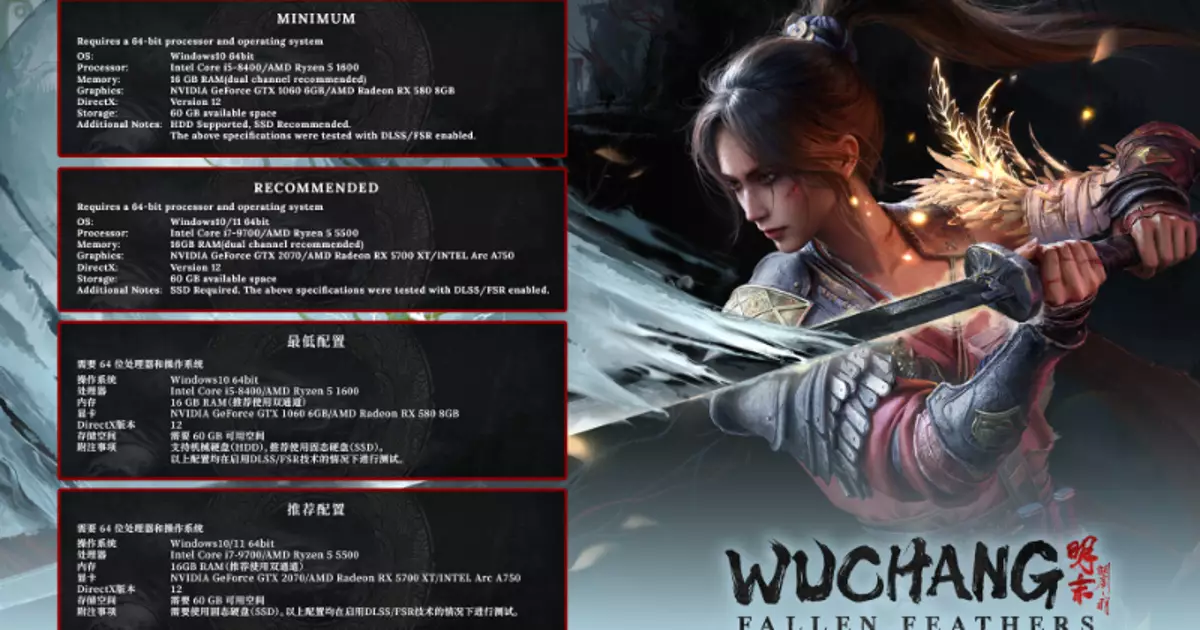Many gamers often associate visually stunning titles with a hefty hardware footprint. However, Wuchang: Fallen Feathers shatters this stereotype by offering grand, fantastical combat against monstrous avian foes without demanding top-tier rigs. With suggested minimum specs that include an Intel Core i5-8400 and a GTX 1060, the game embraces a wide audience, ensuring that even modestly powered PCs can partake in its rich, chaotic world. This deliberate choice hints at the developers’ understanding that extraordinary adventures shouldn’t be reserved for the elite few with bleeding-edge gear. Instead, Wuchang invites a broader spectrum of players to experience its dark, supernatural vision of the Ming dynasty, blending lore, fast-paced combat, and a layered narrative with accessible requirements.
The strategic decision to lean on SSD storage rather than HDD underscores an emphasis on fluidity and performance, vital for a game driven by precise combat mechanics and seamless exploration. With 60GB of space needed, Wuchang swaps unnecessary sophistication for core gameplay experiences, a move directly contrasting many AAA titles that balloon in size to accommodate bloated assets. This thoughtful approach demonstrates confidence that immersive content isn’t solely defined by size but rather by depth and ingenuity.
Crafting a Distinctive World Built on Dark Parallels and Mythical Horror
Wuchang’s narrative draws inspiration from the timeless theme of a plague-ridden world, echoing dark fantasy titans like Bloodborne but steering clear of direct mimicry. Instead of a Gothic, blood-red Yharnam, the developers have reimagined Shu, a land ravaged by the Feathering disease that turns inhabitants into plumage-covered mutants. This creative pivot provides a fresh perspective, emphasizing beauty and grotesqueness intertwined—wings and feathers symbolize both survival and decay.
The game’s setting isn’t just a backdrop for mindless combat but a living, breathing canvas where every choice influences outcomes. As the protagonist, a pirate swordswoman suffering amnesia, players are thrust into a quest of self-discovery amidst a city teetering on the brink of chaos and metamorphosis. Here, player agency shapes the narrative’s direction, with multiple endings contingent upon secrets uncovered, allies trusted, and moral or strategic decisions made. Such depth elevates Wuchang beyond simple hack-and-slash, positioning it as a thinking player’s action RPG that demands engagement on multiple levels.
Furthermore, the visual upgrades offered since 2021 indicate a conscious intent to craft an environment less reminiscent of traditional blood-soaked locales, instead presenting a more nuanced, atmospheric world. The grotesque beauty of feathered monsters, combined with visceral boss fights and a progression system involving “Red Mercury” and weapon enchantments, injects a satisfying blend of strategy and adrenaline.
Innovative Gameplay in a Mythical Plague-Ridden Realm
Central to Wuchang’s gameplay is its combination of fast combat, imagery-driven power-ups, and a narrative tapestry that encourages experimentation. The use of “Red Mercury” as a means to unlock techniques is a compelling concept—implying a dark resource harvested from foes or the environment—adding an ominous layer of lore and morality. Upgrading weapons for more domineering damage is a familiar mechanic, yet the game’s narrative context makes each upgrade feel consequential. Players will need to adapt their tactics, balancing melee prowess with ranged, elemental attacks, or bird-themed powers.
The game’s design seems to embrace the philosophy of giving players the tools to customize their journey. Choices made during the game are not superficial; they steer the story into divergent paths, culminating in multiple endings that reward curiosity and strategic thinking. This encourages repeated playthroughs, giving Wuchang longevity beyond its initial allure.
Hardware-wise, developers lean on modern tech like DLSS 4 to optimize performance, demonstrating an understanding that players expect high-fidelity visuals without sacrificing frame rate. This inclusion hints at Wuchang’s ambition to provide visually compelling combat sequences, all while maintaining accessibility for a wide range of gaming systems.
Challenging Conventions with a Bold Aesthetic and Gameplay Philosophy
Unlike many contemporary action RPGs that lean heavily on realism or minimalism, Wuchang’s aesthetic boldly embraces surrealism and mythos. The feathered plague, the amnesiac pirate warrior, and the mythic setting challenge players to re-evaluate notions of beauty, monstrosity, and heroism. It pushes past the tired tropes of dark fantasy, opting instead for a universe where transformation—both literal and metaphorical—is at the core of its identity.
By blending traditional Chinese mythology with inventive design, Wuchang offers a fresh narrative playground. Its combat system, narrative depth, and visual stylization set it apart as a title that refuses to follow the crowd. For those tired of the same ol’, same ol’ in the action-RPG genre, it promises an experience that is not only challenging but also visually arresting and narratively compelling.
In essence, Wuchang: Fallen Feathers embodies a bold leap forward, not just in gameplay but in thematic depth. It showcases how a game can be approachable yet innovative, visceral yet thought-provoking. As it prepares to launch, it stands out as a testament to creative courage and a potential game-changer for fans hungry for new stories painted with bold strokes of imagination.

